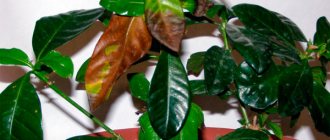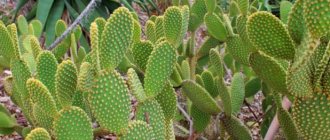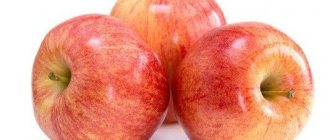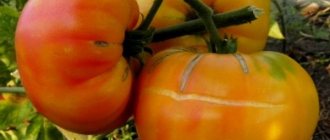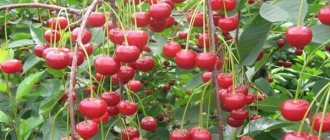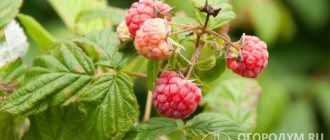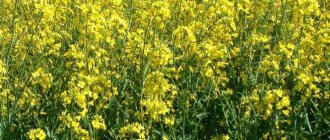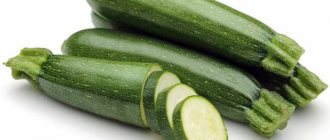Thorn (Prunus spinosa), also called prickly plum, or blackthorn, or damson, is a thorny, not very large shrub that is a representative of the genus Plum of the subfamily Plum family Rosaceae. The name of this plant comes from the Proto-Slavic language and is translated as “thorn”. In nature, thorns can be found in regions with a temperate climate. It often forms very dense thickets, and prefers to grow in cutting areas and along forest edges, in steppes and forest-steppes. Sloes are found at an altitude of 1200 to 1600 meters above sea level in the Caucasus and Crimea. This plant can also be found in North Africa, Asia Minor, Ukraine, Western Europe, the Mediterranean, Western Siberia, and also in the European part of Russia. Man learned about the existence of thorns a very long time ago; it was known during the times of Rome and Ancient Greece. In Christianity, the thorns of such a bush are considered a symbol of the suffering of Jesus Christ. A thorn bush engulfed in fire was also mentioned in the Holy Scriptures: “And the Angel of the Lord appeared to Moses in a flame of fire from the midst of the thorn bush. And he saw that the thorn bush was burning with fire, but the bush was not consumed... and God called to him from the midst of the bush and made him leader of his people.”
Sloe propagation methods
Sloes are propagated using seeds, cuttings or root suckers. The seed method is time-consuming. As practice shows, vegetative propagation is much more successful.
Propagation by seeds
In September, the fruit seed is separated from the pulp and placed in the soil. Planting is done in the spring after seed stratification. To make them germinate faster, the seeds are soaked in honey syrup for several hours. After this, they are planted in nutrient soil, deepening 6 cm into the ground. The plantings are covered with film to create a greenhouse effect. When a couple of healthy leaves appear, the cover is removed. After two years, the seedlings are ready to be transplanted to a new location.
Propagation by cuttings
For cuttings, select cuttings that have 5 healthy buds. With the arrival of spring, they are placed in a container filled with fertile substrate, lightly covered and transferred to the greenhouse, trying to ensure constant watering and fertilizing. After 3-4 months, the cuttings take root.
Reproduction by offspring
The root shoots are carefully separated from the main bush, after which they are planted in shallow holes. It is better to maintain an interval of at least a meter between individual copies.
Sloe propagation
Blackthorn as a symbol of faith
Self-rooted seedlings are highly valued; the simplest and most reliable way to obtain them is considered to be propagation by root shoots. It is harvested in the fall or spring, choosing only the most productive and outwardly healthy plants; in the future they can be used as queen cells. When propagating in this way, root suckers are chosen that are located at some distance from the trunk; these usually have a much better developed root system, and they can be separated from the mother plant without fear of damaging it.
The method of obtaining seedlings by grafting is more complicated; in order to implement it, you need to first grow rootstocks, for which seedlings of winter-hardy plum varieties are quite suitable; felt cherry is also considered a good rootstock, moreover, this rootstock helps reduce the growth of the scion by 35-40%.
To obtain a seed rootstock, simply sowing the seeds into the soil is not enough; for good germination, they need stratification in the refrigerator, which lasts 4-5 months. You can, of course, sow seeds in the fall so that they undergo natural stratification in the soil, but their germination rate is reduced by 25%.
Caring for seedlings consists of weeding, loosening the soil, watering and fertilizing. At the end of September - beginning of October, seedlings are dug up and, having previously trimmed the roots and shortened the above-ground part to 16-20 cm, they are buried for the winter. In spring, seedlings are planted, placing them in such a way that the distance between them is at least 15-20 cm.
The easiest way to propagate sloe is by root suckers, making good use of its ability to quickly form a large number of root shoots. The shoots are carefully separated from the mother bush and planted in prepared holes. It is recommended to mulch the tree trunk circles around the plants with a layer of peat.
Thorns are the kings of unpretentiousness
Sloes and damsons are one of the most unpretentious garden crops. They bear fruit consistently in the most unfavorable weather years. They can grow in both sun and shade. Any soil is suitable, even calcareous. Both crops tolerate heat, drought and frost very well - even -40 °C is nothing for them!
They do not require any maintenance. Well, except that on poor soils it is useful to feed them once every 2-3 years with complex fertilizer. And in order for the tree to look neat, in the spring it is necessary to remove all damaged shoots.
Sloes and damsons can be propagated by seeds (they are sown in the fall) or by layering and cuttings (they take root easily).
The planting hole can be any size, as long as the distance between plants is at least 1 m.
variety description, photo
Plum growing tips and best varieties
Late ripening, coral-red, round-oval, large fruits - on average 25 g, with notes of tartness, sweetness and sourness
Damson is a hybrid of sloe and plum, one of the most winter-hardy fruit crops. A fairly new stone fruit crop that, thanks to crossing, is resistant to damping off. The damson is just beginning to spread. And thanks to its characteristics, it is definitely of interest for amateur and professional gardening. And here's why. From sloe it took: - high winter hardiness - simply created for growing in Siberia! - resistance to diseases - endurance - no matter what the weather is. The best things came from plums: - high yield - excellent taste of the fruit.
Description of the variety:
Late ripening period - September. Damson gives a unique opportunity to enjoy the plum season even with the arrival of autumn. Just like a real plum, only the fruits are more fleshy and just a little tart with notes of sweetness and sourness. The beautiful red-coral fruits are large - on average 25 g! – more than some varieties of plums! The taste of damson plums is especially good when preserved and in syrups. The pride of Siberia is large harvests every year! An unpretentious and winter-hardy variety. A lucky find for every gardener! Due to late flowering, it is reliably protected from return frosts
The entire tree, 3-5 m high, in June-July is literally strewn with snow-white flowers - an amazing sight! And during the fruiting period, the branches are literally bursting with abundance of fruit! Therefore, it is important to place supports under the branches
Reviews
Grigory Mishin, Novosibirsk: I really love my damsons. It requires virtually no maintenance, and the yield is finger-licking good. The fruits are sweet and sour, very similar to plums, but with a pleasant tartness that gives them a special piquancy.
Arina Stepanovna Zorkina, Tyumen: The damson plum has been growing on the plot for three years and has given its first harvest. The berries are tasty, spherical, dark blue with a waxy coating. Sweet, slightly more sour than plums. And, of course, the signature astringency that the plant inherited from the sloe.
Lyubov Ignatova, Yekaterinburg: Recently I planted a damson plum seedling, which I took from a neighbor. My tree is still young, but from observations they can say that it will not grow very tall, but will produce a lot of fruit. Everyone in my family loves them: eaten raw and in jam.
Caring for thorns in the garden
Norway maple Crimson King
Caring for thorn shrubs is quite simple and even a novice gardener can do it.
It is important to follow several rules: regularly water, feed the plant, loosen the soil, remove weeds, trim branches that are too thick, cover the bushes for the winter
Watering
Immediately after planting the sloe, the young bush will only need one watering per week, then watering is reduced. Only when the blackthorn begins to actively grow, the moisture supply is resumed. During the year, the shrub has enough natural rainfall, but if a prolonged drought occurs, two buckets of settled water are poured under the seedlings.
Feeding
For normal and abundant fruiting, it is necessary to feed the sloe with organic or mineral fertilizers once a season. Bushes that grow in the same place for a long time need to be fed first.
Trimming
Thorn pruning activities are carried out in the spring, before sap flow begins. Dried and deformed branches are removed. Blackthorn has a tendency to thicken, as a result of which the crown should be thinned out regularly. You can leave only five strong fruiting branches. The cup-shaped bush shape is most common for garden growing of sloe.
In autumn, pruning of plants is performed exclusively for sanitary purposes, in order to get rid of old and broken branches. This is done after the foliage has fallen and the thorn bushes are preparing for winter.
Features of agricultural technology
The planting pattern depends on the variety - the strength of its growth, the diameter of the crown, and can be either 5 x 3, 3.5 x 4.5 or even 3 x 3 m. Damon seedlings, like the vast majority of crops, are planted in planting pits , the dimensions of which are 60-70 cm in width and 40-50 cm in depth, but can vary depending on the degree of development of the root system, that is, they can be larger or smaller.
It is advisable to add fertilizers to the planting hole, which will help the plant quickly “get accustomed” to the new place. Usually humus, superphosphate and sodium sulfate are added, and, of course, the top fertile layer of soil in equal proportions in a total amount equal to a bucket. After planting, the root collar of the seedling should be 2-3 cm above the soil level.
Care. As for care, in the first few years after planting it comes down to weeding and watering, then, as the plants mature, you need to apply fertilizers, both mineral and organic. It is imperative to ensure that the soil around the tree trunks is constantly loose and free of weeds.
Feeding. It is better to apply mineral fertilizers as follows - in the spring, a tablespoon of nitroammophoska for each tree, or dissolved in water, at the end of flowering - a teaspoon of potassium sulfate and superphosphate (or a tablespoon of potassium sulfate per bucket of water), after fruiting - according to 250 g wood ash.
Trimming. A few words should be said about the formations. Amateur gardeners often ignore this process, however, it is also important. Damon plants are formed either in a sparsely layered system, or they give the plant a bushy shape. Subsequently, in order to preserve the shape given to the plants, they carry out sanitary and anti-aging pruning, and also remove excess shoots.
When bushes age, they are rejuvenated by strong shoots; the same is done when plants are damaged by severe frosts.
Diseases and pests. Of the diseases, the most dangerous is hole spot, and of the pests, the ringed silkworm; they are fought with the usual methods - approved fungicides and insecticides.
Rules and nuances of planting and caring for plants
The bush is planted at the beginning of spring, but preparation of the planting site begins in the fall. This is due to the fact that the soil will settle sufficiently during the winter and become stable.
Thorn grows best on clayey, saline, dry and sandy soil. Spring melting does not affect the condition of the prickly hedge, but you should not allow moisture to stagnate. To do this, you will need to equip soil drainage.
It is recommended to plant young plants on soil that is not weighed down by the abundance of water. Too wet soil will cause frostbite to the seedlings.
It develops well in illuminated fertile areas with neutral soil composition.
The depth of the dig is approximately equal to its width and is 60 centimeters.
The root system is prone to profuse growth, so its size will need to be controlled. To ensure regulation of the root size, at the planting stage it is necessary to lay sheets of iron, slate or other artificial durable material on the sides of the holes.
Planting is carried out in the spring. Beforehand, about 7 days before planting begins, a layer of eggshells must be laid on the bottom of the excavated space, which is covered with a mixture of local soil, superphosphate, compost and fertilizer. A distance of 1.5 meters is maintained between the bushes.
Planting material is purchased when it is 2 years old and must be prepared before work. For this purpose, the root system is immersed inside a mixture of half a bucket of clean water with 3-4 tablespoons of sodium humate.
The free space around the trunk is fenced off with an earthen border about 10 centimeters high. Next, you need to water the bush abundantly, using 20 to 30 liters of water.
To reduce the frequency of wetting of the bushes, a layer of mulch is laid on the surface of the ground.
Immediately after immersion into the soil, the bushes shorten the stems. Sanitary pruning, shaping haircut - everything is carried out with the onset of spring, but before the first buds swell.
Vegetation does not require careful care. Quite systematically:
- carry out watering;
- loosen the soil around the trunk;
- apply fertilizers;
- pull out weeds;
- remove excess growth from the roots;
- carry out mechanical processing.
Blackthorn propagation is carried out by seed or vegetatively. Growing plants from seeds is a very time-consuming and labor-intensive process. To speed up the process of creating a green fence, preference should be given to the vegetative method.
It is also possible to propagate the bush through root shoots or cuttings. Cuttings are selected based on the presence of at least 5 healthy buds. In spring they are planted in containers with fertile soil. Next, the container with seedlings is covered with a transparent cloth or transferred to greenhouse conditions. All summer you will need to regularly water the seedlings and apply fertilizer. Already in the fall, such cuttings will develop into full-fledged planting material, with a stronger root system.
The plant loves good access to sunlight, which is very important for abundant fruiting and flowering of the bush. Has increased resistance to pests, with the exception of those sucking tree sap, such as aphids
The pest sucks out the cell sap of growing young growth and foliage, after which they turn yellow and lose their appearance. It is a very prolific species, which can greatly harm plantings. In order to get rid of aphids, it is possible to spray with a solution of acaricidal decoction
It has increased resistance to pests, with the exception of those sucking tree sap, such as aphids. The pest sucks out the cell sap of growing young growth and foliage, after which they turn yellow and lose their appearance. It is a very prolific species, which can greatly harm plantings. In order to get rid of aphids, it is possible to spray with a solution of an acaricidal decoction.
The fruits of the plant are included in medications, however, there are contraindications. The berries contain a lot of acid, so they should not be consumed by people with gastritis, ulcers or high acidity of the stomach. Freshly squeezed sloe juice is used to treat intestinal problems. A decoction based on its fruits is used as an anti-inflammatory agent for the gastric mucosa.
Video information about choosing and planting thorn bushes:
Benefits and harms
It is very easy to grow damson plums - the tree does not require any special care. At the same time, the fruits of blackthorn are extremely useful; they are its main value. The fruits of damsons contain amino acids, minerals, vitamins, pectin, coumarins, tannins, and monosaccharides.
Benefits of damsons:
- improving the functioning of the cardiovascular system;
- dilation of blood vessels, preventing the formation of blood clots;
- normalization of the gastrointestinal tract;
- removal of waste and toxins;
- preventing the accumulation of radioactive elements in the body;
- improvement of metabolism;
- increasing immunity.
The fruits of damsons are a low-calorie product, therefore they are actively used in diets.
The gardener shows damson fruits in his video and talks about the form in which he eats them:
Blackthorn fruits can cause an allergic reaction. They can also harm people:
- with increased stomach acidity;
- with exacerbation of chronic gastritis or stomach ulcers.
Damons cannot be called tasty - they are very tart, but they make excellent preparations - jams and compotes. The berries can be dried and frozen, and the leaves can be added to tea. In European cuisines, damsons are used to prepare seasonings and sauces.
The fruits of damsons cannot be eaten without counting. You should not eat more than 200 g of damsons per week - this is what nutritionists advise. These 200 g are not eaten at once, but in 2-3 doses, every other day. If you eat damson fruits on an empty stomach, you will have an upset stomach and diarrhea.
It is forbidden to eat damson pits - they contain a high content of toxic components that can poison the body.
Diseases and pests of thorns
The thorn is very resistant to both diseases and pests. Sometimes it can be affected by moniliosis, or gray mold - a fungal disease caused by the monilius fungus, which penetrates through the pistil of a flower and affects young shoots of thorns. As a result of the development of the disease, the leaves and shoots become dark brown. The disease progresses through the plant from top to bottom. And although new greenery grows on the trees, by the end of summer it turns yellow and falls off, the plant’s productivity decreases, and the surviving fruits crack and rot right on the branches.
In the fight against moniliosis, you will have to resort to the help of fungicides. In early spring, the bush is treated with Horus solution - this is the only drug that works even at low air temperatures. Later, when warm weather sets in, the sloe can be treated against moniliosis with such preparations as Abiga-Pik, Gamair, Rovral, Bordeaux mixture and copper sulfate. Solutions are prepared in accordance with the instructions.
Among the pests, the ubiquitous aphid, a sucking insect that feeds on the cellular sap of the leaves and shoots of the thorn, is dangerous for the thorn, causing them to turn yellow and become deformed. Aphids are very prolific, so they can cause significant harm to the plant, and they are also a carrier of incurable viral diseases. Aphids can be destroyed by treating thorns with a solution of an acaricidal drug, for example, Aktellika, Aktary, Antitlina and the like, and you will have to treat the bushes against aphids more than once.
Specifications
The pride of Siberia reaches the average height of a common plum - 3-5 m - and has a rather spreading crown. But, unlike the plum, its branches are covered with thorns.
Did you know? Blackthorn fruits can be mistaken for blueberries because they look the same as the latter. The difference is that blueberries have umbilical indentations at the bottom and a perfect round shape.
Characteristics of the Pride of Siberia:
- grows in the form of a tree;
- blooms profusely in spring;
- forms many fruits along the entire length of the branches;
- fruit weight: up to 25 g;
- diameter: 4 cm;
- color: dark red;
- pulp: fleshy, red, with notes of sweetness and sourness at the same time;
- ripening period: September (the variety is considered late).
Pride of Siberia is a winter-hardy variety and can be grown in regions with winter temperatures below -40°C. In addition, the variety is resistant to damping off, so it tolerates damp areas or periods of prolonged rain. But it does not tolerate swampy areas and salt marshes.
Harvest and storage
Harvesting can begin when the fruits turn dark purple in color with dark yellow flesh. This happens in September-October. It is best to collect fruits on a sunny, dry day. The harvest must be sorted and placed in wooden boxes. Without processing, it can sit for a month in a cool, ventilated area.
You will be interested to know how cherry plum differs from plum.
For longer storage, it can be placed in the refrigerator or freezer and processed into preserves, jams, and compotes. You can also simply dry it. Sloes are a very healthy berry, although they have a specific taste that not everyone likes. But if you make jam or compote from it, you can get a tasty and healthy treat.
Appearance of damsons and the most popular varieties
The damson is a shrub or tree, consists of many trunks, is covered with thorns, and grows up to 3-8 meters. The second name is wild plum. It bears fruit with edible berries with a somewhat tart taste. They are used for eating, making drinks, and medicines. They contain many useful substances: vitamin C and E, fiber, steroids, carbohydrates, malic acid, flavonoids and so on. It is distinguished by increased resistance to negative temperatures, frost, drought, diseases, and attacks from pests. The leaves are oblong, elliptical in appearance, no more than 4 centimeters long. Young leaves are covered with down, adult leaves are pubescent or bare. The flowering period begins with the blossoming of the crown, but maybe earlier, lasting 15-20 days. Flowers with a diameter of less than 1 centimeter, from 1 to 3 pieces in bunches.
It is unpretentious to soil composition and acidity level, and can grow on dry soil. Does not tolerate stagnant moisture or highly salted soil. Prefers well-lit areas and tolerates saline soil. The root system grows greatly, so growth will need to be monitored regularly.
It bears fruit from July-August with dark purple berries, usually not large, extremely healthy: they contain a high content of nutrients. They do not fall off the branches for a long time, and under the influence of frost they become less tart. Round in shape, the stone is difficult to separate from the pulp in almost all subspecies. One bush can actually produce about 12-15 kilograms of berries. The berries begin to ripen on blackthorn trees when they are 3 years old, and sometimes even in the 2nd year of growth.
The branches of most varieties are covered with sharp spines, which will help create a real living defense. But it is not recommended to plant shrubs near paths, paths, buildings, as there is a high risk of injury and damage to clothing.
The purple variety is distinguished by white-pink flowers during flowering, forming wide shields, and young leaves are purple, but as the plant grows they turn green. The crown reaches a length of 3 meters and has a compact appearance. The fruits are black in color with a bluish bloom. It tolerates winter well, but shoots that grow one summer may freeze.
The Burluk species stands out due to its short stature and rapid fruiting. The yield of one plant is about 20-25 kilograms. It grows 3-4 meters, has a rounded crown, which consists of medium or large foliage, wide oval shape. The round berries are colored dark purple and covered with a waxy coating.
Red-leaved blackthorn exists in the form of a tree and a bush and grows at an average rate. Young foliage of intense red color acquires a green tint towards the end of summer. Suitable for machining. It bears fruit with small berries that have poor taste.
Sweet blackthorn TSHA is a plant with a pleasant taste and no astringency in the taste of the berries. It can survive even harsh winters and bears fruit abundantly. Reaches a height of 3 meters, well separates the stone from the pulp.
Bilasuvar grows up to 300 centimeters. The shrub is unpretentious to soil composition and acidity level. The flowering period begins late, survives winter and frost well. The fruits are very sweet, slightly astringent, with a sweet and sour taste. Resistant to various diseases and attacks from harmful insects.
Cross No. 1 grows up to 2.5 meters in height. It bears fruit with violet purple berries, the surface is covered with a dense waxy coating, large ones - from 6 to 7 grams in weight.
The yellow-fruited sloe is a second-generation hybrid from the crossing of sloe and cherry plum. It has a yellow tint to its berries, which is unusual for a wild plum. The taste of the fruit is average.
Cherry-plum, otherwise called cherry bush, reaches a length of 3 meters. The crown is of medium density, rounded in appearance. The round berries are dark purple in color with a waxy coating and weigh 5-6 grams. The pulp is dense, green in color, and has a sour, tart taste.
The cherry plum variety grows no more than 300 centimeters. bears fruit with very large berries, weighing about 8-9 grams, purple in color with a waxy coating. Under the skin they are green, sweet and sour, slightly tart.
Nutritional and medicinal properties of the culture
Planting and caring for the damson varieties considered should not be difficult even for not very experienced gardeners. The basic principles of cultivation are not much different from the rules for caring for garden plums, only expressed in a simplified form:
- Selection of planting material. Growing a tree can be started from a seedling, a seed, or by grafting onto a regular plum tree. The simplest and most effective way to plant damsons is, of course, to plant a ready-made seedling. When choosing a sprout, preference should be given to a two-year-old plant with a well-developed root system.
- Choosing a landing site. The damson plum is not at all picky about the soil; it only tolerates swampy and overly salty soils. But if possible, it is better to choose soil with low acidity or adjust it by adding lime. Another nuance is that planting should be planned with a diameter of 4-5 m per tree.
- Planting damsons. Planting is recommended in the spring. A hole is dug, 50 cm deep and 70 cm in diameter. You can lay drainage at the bottom using crushed stone and sand. Mix the soil with manure and ash. The seedling is placed in the hole, the roots are carefully straightened and covered with prepared soil. After planting, the root collar should protrude 2-3 cm above the ground level. The tree is watered abundantly, and mulching can be done.
- Fertilization and care of damsons. The young damson tree grows rapidly and additional fertilizer is not recommended. During this period, before fruiting begins, it is enough to loosen the soil and, if necessary, water. Trimming should also be done shallow, gradually forming the crown. Already 3-4 years after planting, with the beginning of fruiting, you can apply organic fertilizers or mineral complexes in spring and autumn. At this time, more serious pruning should be carried out, removing young pagons and forming a crown with 4-5 main branches.
The damson is resistant to diseases and pests, but can sometimes be affected by fruit rot, damson, and dwarfism. In such cases, the wood is treated with special means.
The fruits of damsons contain up to 10% sugars, about 12% organic acids, as well as biologically active pectin and mineral substances necessary for a full human life.
The fruits themselves and their processed products are often used for medicinal and preventive purposes, especially to improve the normal functioning of the stomach and intestines (especially with low acidity). Damon fruits and their processed products are contraindicated for people suffering from heartburn or increased acidity of gastric juice.
Damson plum is a subspecies of domestic plum, which belongs to the genus Prunus. From the name it is clear that not everything is so simple here - this is a natural hybrid of plum and sloe, and it turned out from the cross-pollination of these two crops in nature. Unlike the rather sweet domestic plum, the fruits of the damson plum have a somewhat astringent taste, thorns can be observed on the shoots, and the plant itself is quite resistant to frost.
Ternosliv, in contrast to the more familiar plum, is distinguished not only by increased winter hardiness, but also by drought resistance, can withstand temperatures down to -37°C and bears fruit completely without watering. It loves full sun, moist, loamy and well-drained soils, rich in nutrients and without excess moisture. As for acidity, neutral is most optimal for it (pH 6.5-7). Does not grow well in excessively dry soils.
Thorn is a completely unpretentious and hardy crop; it is a winter-hardy and drought-resistant plant. Its main “weakness” is good illumination of the area where it grows. It can also live in partial shade, but in this case flowering and fruiting will be less abundant.
The root system is located at a depth of up to 1 m, the roots are quite branched and extend far beyond the crown.
The soil should be with good drainage, fertile and moist, neutral in acid reaction.
Many gardeners recommend adding a layer of eggshells to the bottom of the planting hole.
An important measure for caring for thorns is the fight against young shoots. If it is not used for crop propagation, it must be removed regularly and carefully. This is done with pruning shears at soil level or cut down along with pieces of root.
Fruit-bearing sloe plants require additional feeding, so organic matter and complex mineral fertilizers are annually applied to the tree trunk circles, and then the soil surface is mulched. As the crop matures, the dose of fertilizer is increased.
Description of prunes Pride of Siberia
The damson plum is also called the Damascus plum. This is a small, tart plum with a dark and seemingly dusty skin, pleasant to the taste. The Damascus plum was originally grown by the ancient Romans, who then spread it throughout Europe and parts of Asia.
But the historical connection between it and the modern damson is quite tenuous. The fruits of the ancient tree were close in taste to the sweet dessert plum. Modern varieties have a more tart taste.
Did you know? Due to the fact that damson pits are difficult to remove, the whole fruit is used in jams. It is believed that the seeds give the jam an almond flavor.
General characteristics:
- deciduous tree with dark bark and dark purple leaves;
- height: up to 6 m;
- type of pollination: self-pollinating;
- fruit: small (10 g) to medium (20–25 g);
- shape: oval;
- color: bluish-violet;
- Ripening: August-September.
Damsons are used to create barriers from living plants (hedging) in garden design. They are also used as barriers to protect less hardy crops from cold winds.
And the fruits are consumed fresh or used in the form of homemade preparations: in jams and jellies, and also as raw materials for the preparation of wines and liqueurs. It is a known fact that the juice from the fruit of this tree was used as a natural dye for camouflage uniforms of the last century. But there is no documentary evidence of this fact.
Harvesting damsons
Sloe Apricot
The damson fruits are usually collected in boxes with a capacity of no more than 10 kg, placing the fruits in 2 layers. Fruits are harvested at a time depending on their further purpose - for example, for fresh consumption or for processing, they are collected in the technical ripeness phase, for transportation - in an earlier period, when the fruits are just beginning to color and become softer, such fruits Stores well even in a regular refrigerator.
Soil preparation and planting
Plum develops well and bears fruit on various types of soils: sod-podzolic, gray forest, chernozem
It is more important that the soil is loose and fertile. Since acidic soils (pH less than 5.5) predominate in the middle zone, it is advisable to carry out liming before planting, adding 0.4–0.8 kg of lime per 1 m2 for digging. Plum planting is done with one-year or two-year-old seedlings (grafted or offspring) or seedlings. You can plant plums in the middle zone both in spring and autumn
It is very important to do this in the early stages: in spring - in April (before buds open), in autumn - in mid-September (1.5 months before the soil freezes). When planted in late spring, the plants become very sick and are stunted in the first year; when planted in late autumn, they do not have time to take root (grab the soil) before frost and may freeze out. If the seedlings are purchased in the fall, then they are dug in, covered with spruce branches, and at the very beginning of winter with snow, then they will overwinter well. In early spring, as soon as the snow melts, the buried seedlings are checked (without digging them out) for damage by rodents, broken branches, or stems. The seedling is dug up from the dig just before planting. Spring planting is carried out at the moment the buds begin to swell. Later spring planting worsens the survival rate of planted plants. Under no circumstances should you plant or replant plants with already blossoming leaves, as this is associated with a high probability of their death. Well-lit, sunny places, protected from cold winds, are most suitable for planting plums. Plantings can be done along fences, but on the sunny side. It is also necessary to take into account that tall trees (apple and pear trees) do not shade it. Therefore, plum trees are planted on the south side of these trees. Distances when planting between rows are 3 m, and in rows - 2.5–3 m. Planting holes are prepared in the fall or early spring 1–2 weeks before planting. They are dug to a depth of 45–50 cm and a diameter of 60–70 cm. The top fertile layer of soil is thrown in one direction, the bottom in the other. A planting stake is installed in the center of the hole and filled 2/3 with the filling mixture. This is up to 10–20 kg of humus, 100–200 g of ammonium nitrate, 500 g of superphosphate, 100–300 g of potassium chloride, 300–400 g of lime, coarse sand for better air and water drainage, as well as some gravel or crushed stone to increase heat capacity of the soil. All this is thoroughly mixed with the soil of the top layer and placed in a hole. The dressing mixture is poured around the stake in a mound. To avoid burning the roots, lime is not added to the planting hole. Before planting, a stake is driven into the center of the hole and an earthen cone is poured from the prepared soil mixture so that the root system can be evenly distributed around it. When planting, the plum roots should be spread out in different directions and covered only with the top layer of soil without fertilizers.
Where and when to buy seedlings
Experienced gardeners advise buying seedlings not in the fall, but in the spring, so as not to store them in storage, but to replant them in the spring.
Many people order young shoots from online stores. But such a purchase carries the risk of purchasing diseased or low-quality material. Therefore, purchase seedlings from familiar gardeners or trusted nurseries.
If there is an ownerless fruit-bearing blackthorn not far from your dacha or garden, choose the specimen you like and dig up a young daughter bush without damaging the roots.
